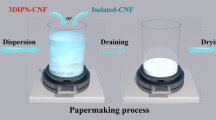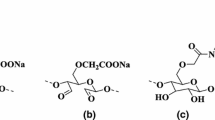Abstract
We investigated the filling process of cellulose-based paper with natural clay nanotubes and their mixtures with hydroxypropyl cellulose (HPC) that is commonly used as glue and consolidant for degraded paper. A comprehensive characterization of the materials was carried out through morphology, wettability, thermal degradation, and tensile properties. The treatment with halloysite nanotubes generated a decrease of the paper mechanical performance and did not alter the thermal properties. The co-presence of HPC and nanoparticles generated a more uniform nanotubes distribution in the paper fibrous structure and a significant enhancement of both the mechanical properties and the surface hydrophobicity with respect to the HPC treatment. This work proposes the use of halloysite/HPC mixture in a new protocol for paper consolidation and represents a starting point to develop, with a biocompatible approach, smart composite material in which the nanotube cavity is filled with active species for paper protection or active response to external stimuli.




Similar content being viewed by others
References
Jana K. Mechanism of autoxidative degradation of cellulose. Restaurator. 2009;18:163–76.
Wp M, Bogaard J. Determination of the cellulose scission route in the hydrolytic and oxidative degradation of paper. Restaurator. 2009;15:26–45.
Havlínová B, Katuščák S, Petrovičová M, Maková A, Brezová V. A study of mechanical properties of papers exposed to various methods of accelerated ageing. part I. The effect of heat and humidity on original wood-pulp papers. J. Cult. Herit. 2009;10:222–31.
Cavallaro G, Donato DI, Lazzara G, Milioto S. Determining the selective impregnation of waterlogged archaeological woods with poly(ethylene) glycols mixtures by differential scanning calorimetry. J Therm Anal Calorim. 2013;111:1449–55.
Donato D, Lazzara G, Milioto S. Thermogravimetric analysis. J Therm Anal Calorim. 2010;101:1085–91.
Strnadovà J, Ďurovic M. The cellulose ethers in paper conservation. Restaurator. 2009;15:220–41.
Shen J, Song Z, Qian X, Ni Y. A review on use of fillers in cellulosic paper for functional applications. Ind Eng Chem Res. 2010;50:661–6.
Tankhiwale R, Bajpai SK. Graft copolymerization onto cellulose-based filter paper and its further development as silver nanoparticles loaded antibacterial food-packaging material. Colloids Surf B Biointerfaces. 2009;69:164–8.
Lvov Y, Abdullayev E. Functional polymer–clay nanotube composites with sustained release of chemical agents. Prog Bionanocomposites Green Plast Biomed Appl. 2013;38:1690–719.
Sciascia L. Turco Liveri ML, Merli M. Kinetic and equilibrium studies for the adsorption of acid nucleic bases onto K10 montmorillonite. Appl Clay Sci. 2011;53:657–68.
Soares NFF, Moreira FKV, Fialho TL, Melo NR. Triclosan-based antibacterial paper reinforced with nano-montmorillonite: a model nanocomposite for the development of new active packaging. Polym Adv Technol. 2012;23:901–8.
Lvov YM, Shchukin DG, Mohwald H, Price RR. Halloysite clay nanotubes for controlled release of protective agents. ACS Nano. 2008;2:814–20.
Abdullayev E, Sakakibara K, Okamoto K, Wei W, Ariga K, Lvov Y. Natural tubule clay template synthesis of silver nanorods for antibacterial composite coating. ACS Appl Mater Interfaces. 2011;3:4040–6.
Cavallaro G, Lazzara G, Milioto S. Dispersions of nanoclays of different shapes into aqueous and solid biopolymeric matrices. Extended physicochemical study. Langmuir. 2011;27:1158–67.
Luo Z, Song H, Feng X, Run M, Cui H, Wu L, et al. Liquid crystalline phase behavior and sol–gel transition in aqueous halloysite nanotube dispersions. Langmuir. 2013;29:12358–66.
Cavallaro G, Lazzara G, Milioto S. Exploiting the colloidal stability and solubilization ability of clay nanotubes/ionic surfactant hybrid nanomaterials. J Phys Chem C. 2012;116:21932–8.
Zhao Y, Abdullayev E, Vasiliev A, Lvov Y. Halloysite nanotubule clay for efficient water purification. J Colloid Interface Sci. 2013;406:121–9.
Qiao J, Adams J, Johannsmann D. Addition of halloysite nanotubes prevents cracking in drying latex films. Langmuir. 2012;28:8674–80.
Cavallaro G, Donato DI, Lazzara G, Milioto S. Films of halloysite nanotubes sandwiched between two layers of biopolymer: from the morphology to the dielectric, thermal, transparency, and wettability properties. J Phys Chem C. 2011;115:20491–8.
Blanco I, Abate L, Bottino FA, Bottino P. Thermal degradation of hepta cyclopentyl, mono phenyl-polyhedral oligomeric silsesquioxane (hcp-POSS)/polystyrene (PS) nanocomposites. Polym Degrad Stab. 2012;97:849–55.
Rotaru A, Nicolaescu I, Rotaru P, Neaga C. Thermal characterization of humic acids and other components of raw coal. J Therm Anal Calorim. 2008;92:297–300.
Duce C, Ghezzi L, Onor M, Bonaduce I, Colombini M, Tine’ M, et al. Physico-chemical characterization of Protein–Pigment interactions in tempera paint reconstructions: casein/cinnabar and albumin/cinnabar. Anal Bioanal Chem. 2012;402:2183–93.
Cavallaro G, Donato DI, Lazzara G, Milioto S. A comparative thermogravimetric study of waterlogged archaeological and sound woods. J Therm Anal Calorim. 2011;104:451–7.
Kučerík J, David J, Weiter M, Vala M, Vyňuchal J, Ouzzane I, et al. Stability and physical structure tests of piperidyl and morpholinyl derivatives of diphenyl-diketo-pyrrolopyrroles (DPP). J Therm Anal Calorim. 2012;108:467–73.
Budrugeac P, Cucos A, Miu L. The use of thermal analysis methods for authentication and conservation state determination of historical and/or cultural objects manufactured from leather. J Therm Anal Calorim. 2011;104:439–50.
Farris S, Introzzi L, Biagioni P, Holz T, Schiraldi A, Piergiovanni L. Wetting of biopolymer coatings: contact angle kinetics and image analysis investigation. Langmuir. 2011;27:7563–74.
Cavallaro G, Lazzara G, Milioto S. Sustainable nanocomposites based on halloysite nanotubes and pectin/polyethylene glycol blend. Polym Degrad Stab. 2013;98:2529–36.
Du M, Guo B, Jia D. Thermal stability and flame retardant effects of halloysite nanotubes on poly(propylene). Eur Polym J. 2006;42:1362–9.
Tang X, Alavi S. Structure and physical properties of starch/poly vinyl alcohol/laponite RD nanocomposite films. J Agric Food Chem. 2012;60:1954–62.
Chivrac F, Pollet E, Dole P, Avérous L. Starch-based nano-biocomposites: plasticizer impact on the montmorillonite exfoliation process. Carbohydr Polym. 2010;79:941–7.
Jin C, Yan R, Huang J. Cellulose substance with reversible photo-responsive wettability by surface modification. J Mater Chem. 2011;21:17519–25.
Aulin C, Shchukarev A, Lindqvist J, Malmström E, Wågberg L, Lindström T. Wetting kinetics of oil mixtures on fluorinated model cellulose surfaces. J Colloid Interface Sci. 2008;317:556–67.
Liu M, Jia Z, Liu F, Jia D, Guo B. Tailoring the wettability of polypropylene surfaces with halloysite nanotubes. J Colloid Interface Sci. 2010;350:186–93.
Marmur A. From hygrophilic to superhygrophobic: theoretical conditions for making high-contact-angle surfaces from low-contact-angle materials. Langmuir. 2008;24:7573–9.
Acknowledgements
The work was financially supported by the University of Palermo, PRIN 2010-2011 (prot. 2010329WPF) and FIRB 2012 (prot. RBFR12ETL5).
Author information
Authors and Affiliations
Corresponding author
Electronic supplementary material
Below is the link to the electronic supplementary material.
Rights and permissions
About this article
Cite this article
Cavallaro, G., Lazzara, G., Milioto, S. et al. Halloysite nanotubes as sustainable nanofiller for paper consolidation and protection. J Therm Anal Calorim 117, 1293–1298 (2014). https://doi.org/10.1007/s10973-014-3865-5
Received:
Accepted:
Published:
Issue Date:
DOI: https://doi.org/10.1007/s10973-014-3865-5




